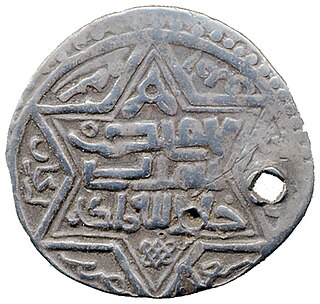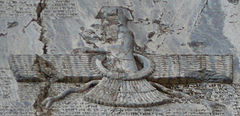Amir Chūpān, also spelt Choban or Coban, was a Chupanid noble of the Ilkhanate, and nominal general of the Mongol Empire. He was ennobled by Emperor Taiding of Yuan as Duke of Yi (翊國公).

Arpa Ke'un, also known as Arpa Khan or Gavon or Gawon, was an Ilkhan (1335–1336) during the disintegration of the Ilkhanate, the Mongol state in Southwest Asia based in Persia.
Baghdad Khatun, was a Chobanid princess, the daughter of Chupan. She was the empress consort of the Ilkhanate as the wife of Abu Sa'id Bahadur Khan.
Musa Khan was an Ilkhan for 4 months.
Shaikh Mahmoud was a member of the Chupanid family who lived in the Ilkhanate. He was the fourth son of Mongol emir and general Chupan.
Hasan Kuchak or Ḥasan-i Kūchik was a Chupanid prince during the 14th century. He is credited with setting up a nearly independent Chupanid state in Iran during the struggles taking place in the aftermath of the Ilkhanate. He effectively became kingmaker like his namesake Hasan Buzurg.
Demasq Kaja or Dimashq Khwāja was a member of the Chobanid family around the first quarter of the 14th century.
Dilshad Khatun, also Delshad, was a Chobanid princess. She was the wife of Ilkhan Abu Sa'id Bahadur Khan, and after him Hasan Buzurg, the first ruler of the Jalayirid Sultanate, and the mother of his son and successor Shaikh Awais.
Shaikh Hasan, also known as "Hasan Buzurg", Hassan the Jalair or Hassan-e Uljatâï was the first of several de facto independent Jalayirid rulers of Iraq and central Iran.

Shaykh Uways Jalayir was the Jalayirid ruler of Iraq (1356–1374) and Azerbaijan (1360–1374). He was the son of Hasan Buzurg and the Chobanid princess Dilshad Khatun.

Muhammad Khan was a claimant to the throne of the Ilkhanate.
Sati Beg was an Ilkhanid princess, the sister of Il-Khan Abu Sa'id (r. 1316–1333). She was the consort of amir Chupan (1319–1327), Il-Khan Arpa (r. 1335–36), and Il-Khan Suleiman (r. 1339–1343). In 1338–39, she was briefly the Ilkhanid khatun during internal conflicts, appointed by a Chobanid faction led by Hassan Kuchak.
Suleiman Khan was a Chobanid puppet for the throne of the Ilkhanate during the breakdown of central authority in Persia.
Jahan Temür was a Jalayirid puppet for the throne of the Ilkhanate in the late 1330s.
Malek Ashraf, was a Chupanid ruler of northwestern Iran during the 14th century. He was the last of the Chupanids to possess a significant influence within Ilkhanate. His regnal name was Giyas al-Din Shah Malek Ashraf.

The Jalayirid Sultanate was a dynasty of Jalayir origin, which ruled over modern-day Iraq and western Iran after the breakup of the Ilkhanate in the 1330s. It lasted about fifty years, until disrupted by Timur's conquests and the revolts of the Qara Qoyunlu Turkoman. After Timur's death in 1405, there was a brief attempt to re-establish the sultanate in southern Iraq and Khuzistan. The Jalayirids were finally eliminated by the Qara Qoyunlu in 1432.

Togha Temür, also known as Taghaytimur, was a claimant to the throne of the Ilkhanate in the mid-14th century. Of the many individuals who attempted to become Ilkhan after the death of Abu Sa'id, Togha Temür was the only one who hailed from eastern Iran, and was the last major candidate who was of the house of Genghis Khan. His base of power was Gurgan and western Khurasan. His name "Togoy Tomor" means "Bowl/Pot Iron" in the Mongolian language.
Yagi Basti was a member of the Chobanid family and the ruler of Shiraz for a part of 1343. He was the son of Amir Chupan by his second wife.

Ala al-Din Eretna was the first sultan of the Eretnids, reigning from 1343 to 1352 in central and eastern Anatolia. Initially an officer in the service of the Ilkhanate officer Chupan and his son Timurtash, Eretna migrated to Anatolia following Timurtash's appointment as the Ilkhanid governor of the region. He took part in Timurtash's campaigns to subdue the Turkoman chiefs of the western periphery of the peninsula. This was cut short by Timurtash's downfall, after which Eretna went into hiding. Upon the dissolution of the Ilkhanate, he aligned himself with the Jalayirid leader Hasan Buzurg, who eventually left Anatolia for Eretna to govern when he returned east to clash with the rival Chobanids and other Mongol lords. Eretna later sought recognition from Mamluk Egypt to consolidate his power, although he played a delicate game of alternating his allegiance between the Mamluks and the Mongols. In 1343, he declared independence as the sultan of his domains. His reign was largely described to be prosperous, with his efforts to maintain order in his realm such that he became known as Köse Peyghamber.

Abu Sa'id Bahadur Khan, also spelled Abusaid Bahador Khan, Abu Sa'id Behauder, was the ninth ruler of the Ilkhanate, a division of the Mongol Empire that encompassed the present day countries of Iran, Azerbaijan, Georgia, and Armenia, as well as parts of Iraq, Turkey, Afghanistan, and Pakistan. After his death in 1335, the Ilkhanate disintegrated.










